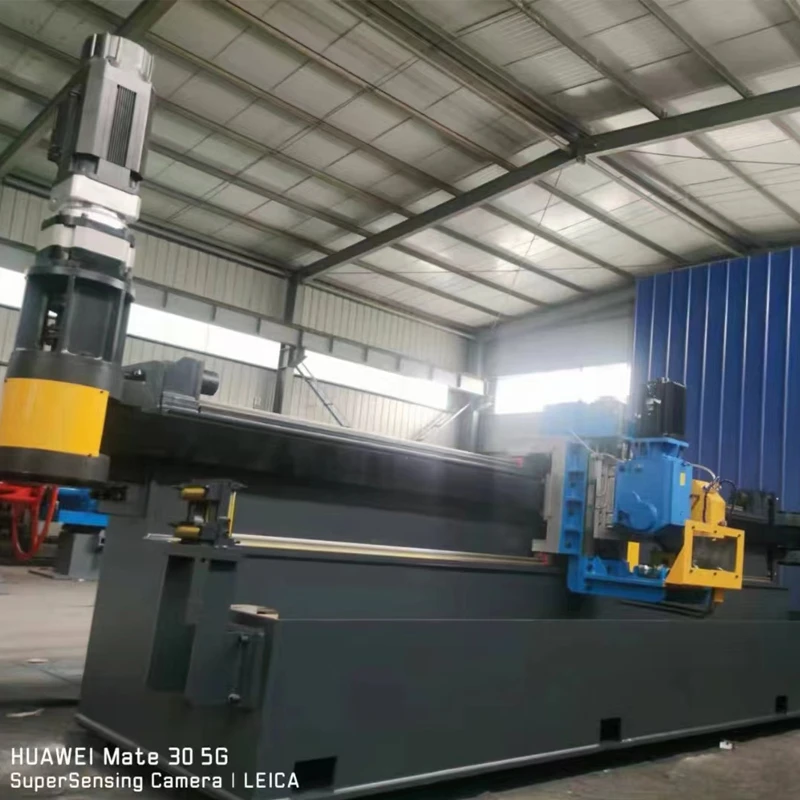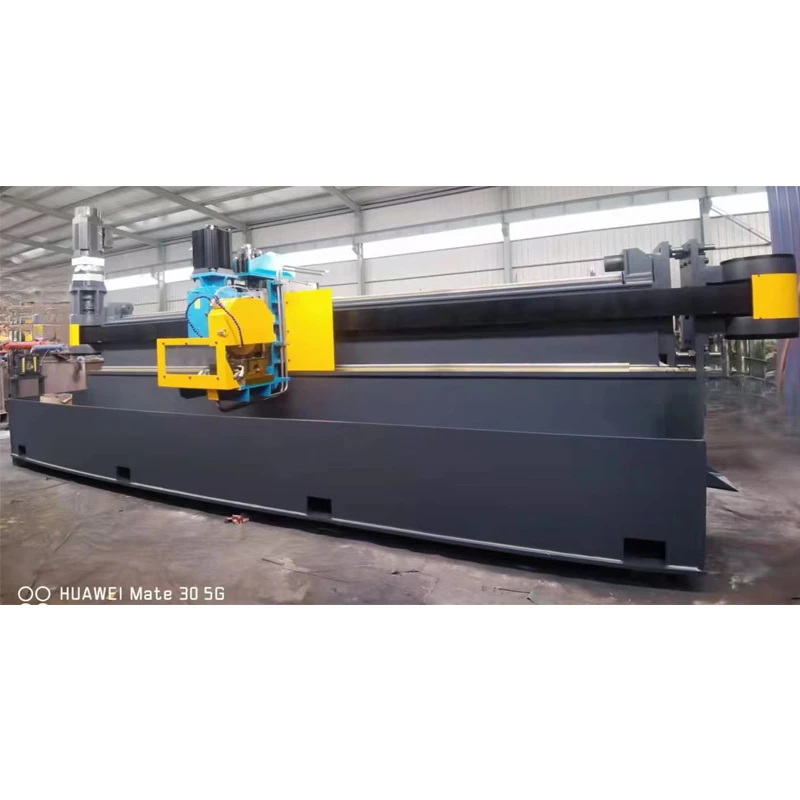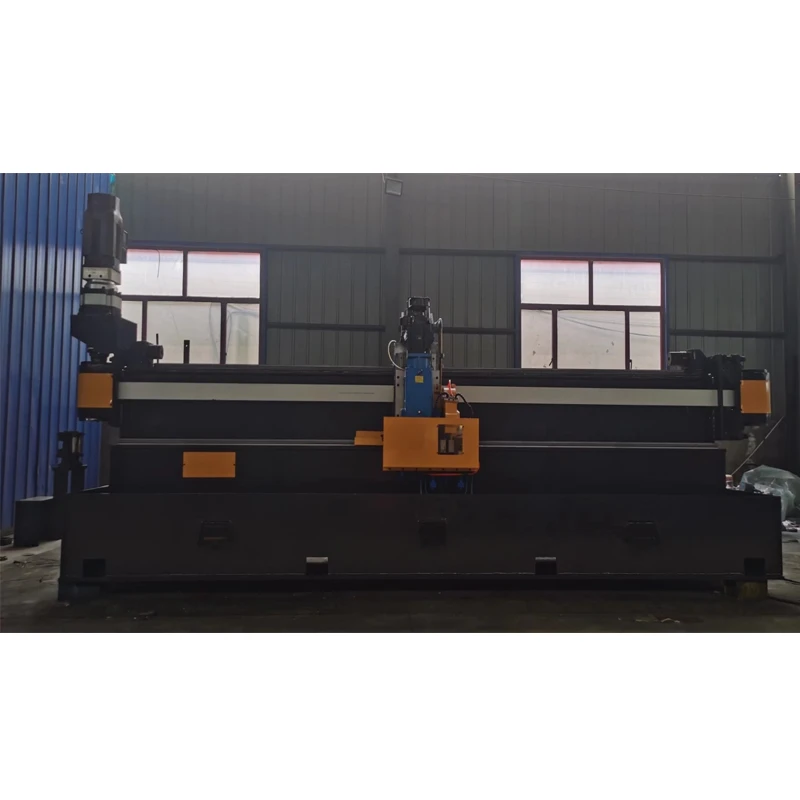Precision Flying Saw & Shear Machines | High-Speed Cutting
The relentless demand for efficiency and precision in modern industrial processes has driven significant advancements in cutting technology. Among these, the flying saw stands out as a critical innovation, particularly for continuous production lines dealing with long products like pipes, tubes, and profiles. Unlike traditional static cutting methods, the flying saw performs cuts while the material is in motion, eliminating the need to stop the production line. This capability drastically reduces cycle times, enhances throughput, and improves overall operational efficiency. This comprehensive guide delves into the intricate details of Cold Cutting Flying Saws, exploring their design, manufacturing, applications, and the distinct advantages they offer to various industrial sectors, including metallurgy, petrochemical, and construction.
Understanding Cold Cutting Flying Saws: An Overview
A flying saw, often interchangeably referred to as a flying shear, is a specialized cutting machine designed for on-the-fly material severance. It moves in synchronization with the product being cut, executes the cut, and then returns to its starting position, ready for the next cycle. Cold cutting technology, as opposed to hot cutting, ensures minimal heat affected zones (HAZ) and distortion, leading to superior cut quality, reduced burrs, and often eliminating the need for secondary finishing processes. This makes Cold Cutting Flying Saws ideal for materials sensitive to heat or those requiring high dimensional accuracy. The sophisticated synchronization systems, typically driven by advanced servo motors and precise control algorithms, are central to the high performance of a modern flying shear machine, ensuring accuracy even at high line speeds.
The design philosophy behind a high-performance flying shear design emphasizes robust mechanical structures, high-speed motion control, and intelligent automation. These machines are engineered to withstand continuous operation in harsh industrial environments. Key components include a saw carriage that accelerates to match product speed, a clamping mechanism to secure the product during the cut, and a high-power saw blade or cutting tool. The integration of advanced sensors and feedback loops allows for real-time adjustments, maintaining precise cut lengths and minimizing material waste. This continuous improvement in flying saw technology directly translates into enhanced productivity and lower operational costs for manufacturers globally.
The Meticulous Manufacturing Process of a Cold Cutting Flying Saw
The production of a high-precision Cold Cutting Flying Saw is a multi-stage process that combines advanced engineering with stringent quality control. It begins with the selection of premium materials, typically high-strength alloy steels for structural components and specialized tool steels for cutting elements, ensuring durability and performance. The main frame and critical load-bearing parts often undergo sophisticated casting or forging processes, which impart superior mechanical properties and reduce internal stresses. For instance, the saw carriage, subject to rapid acceleration and deceleration, is frequently made from high-grade ductile iron or fabricated steel sections, which are then meticulously machined.
Following initial material shaping, precision CNC machining plays a pivotal role in achieving the tight tolerances required for seamless operation. Components like gearboxes, guide rails, and clamping jaws are machined to micron-level accuracy. Heat treatment processes, such as carburizing or induction hardening, are applied to critical wear parts to enhance their hardness and abrasion resistance, significantly extending the service life of the flying saw machine. Assembly takes place in clean environments, with skilled technicians meticulously fitting components and calibrating motion systems. Every machine undergoes rigorous testing protocols, including functional tests, load tests, and endurance tests, to ensure compliance with international standards such as ISO 9001 for quality management and ANSI standards for specific mechanical components. This comprehensive process guarantees that the final product meets the demanding performance requirements of industries like metallurgy and petrochemicals, delivering exceptional reliability and reduced downtime.

Fig 1: Precision components demonstrating the intricate flying shear design.
The operational lifespan of a well-maintained Cold Cutting Flying Saw can easily exceed 15-20 years, thanks to its robust construction and high-quality components. Applicable industries are vast, ranging from steel mills producing seamless pipes and profiles (metallurgy) to manufacturers of specialized tubing for chemical processing (petrochemical) and large-diameter pipes for water infrastructure (water supply and drainage). In these typical application scenarios, the flying saw offers significant advantages. Its ability to cut without stopping the line dramatically reduces energy consumption associated with start-stop cycles, leading to substantial energy savings. Furthermore, for applications involving corrosive media or harsh environments, specialized coatings and material selections can be integrated into the manufacturing process, providing enhanced corrosion resistance and extending the lifespan even further in challenging conditions.
Key Technical Parameters and Specifications
When evaluating a Cold Cutting Flying Saw, understanding its technical parameters is crucial for matching the machine to specific production requirements. These parameters dictate the machine's capacity, precision, and operational efficiency. Below is a representative table outlining common specifications for advanced flying shear machines. It's important to note that these values can vary significantly based on the specific model and customization options. For instance, the maximum cutting speed directly impacts throughput, while the cutting accuracy determines the quality and usability of the finished product.
| Parameter | Typical Range / Value | Unit | Description |
|---|---|---|---|
| Material Diameter/Profile Size | Ø 20 mm - 400 mm | mm | Range of material cross-sections the saw can process. |
| Max. Line Speed | 30 - 180 | m/min | Maximum speed of the product line the saw can synchronize with. |
| Cutting Length Accuracy | ± 1.0 - ± 3.0 | mm | Precision of the cut length. |
| Cut Time (Cycle) | 0.5 - 1.5 | sec | Time taken for one complete cutting cycle. |
| Installed Power | 75 - 300 | kW | Total electrical power required for the machine. |
| Noise Level | < 85 | dB(A) | Typical noise output during operation. |
These specifications are paramount for engineers and production managers. For example, a higher "Max. Line Speed" indicates greater throughput potential, while a tighter "Cutting Length Accuracy" minimizes material waste and ensures product conformity. Understanding these figures allows for proper system integration and optimization of production lines. The integration of advanced sensors and real-time feedback mechanisms ensures these parameters are consistently met, even under varying operational loads.
Application Scenarios and Strategic Advantages
The versatility of Cold Cutting Flying Saws makes them indispensable across a spectrum of industrial applications where continuous, high-precision cutting is required. In the metallurgical industry, they are extensively used in steel and aluminum rolling mills for cutting hot-rolled and cold-drawn tubes, bars, and structural shapes to precise lengths as they exit the finishing stands. For the petrochemical sector, these machines are vital for producing pipelines and conduits that demand stringent quality and dimensional integrity, crucial for safe and efficient fluid transport. The environmental sector, particularly in water supply and drainage projects, also benefits from the speed and accuracy of these saws for large-diameter pipe production.

Fig 2: A flying shear machine efficiently cutting pipes on a continuous production line.
Beyond their broad applicability, Cold Cutting Flying Saws offer several strategic advantages. Firstly, the "cold cutting" process itself is a significant benefit. Unlike hot saws or abrasive cutting, cold cutting minimizes or completely eliminates heat-affected zones (HAZ), preventing metallurgical changes and material deformation. This results in cleaner, burr-free cuts that often do not require subsequent deburring or grinding, thereby reducing processing time and labor costs. Secondly, the synchronous motion enables uninterrupted production, significantly boosting throughput and overall line efficiency, directly translating to higher profit margins. Thirdly, the integration of advanced control systems ensures superior cutting accuracy, reducing material waste and improving product consistency. This level of precision is critical for industries with strict quality control requirements.
Furthermore, the robust design and engineering typical of a high-quality flying shear machine contribute to a longer service life and reduced maintenance requirements. This lowers the total cost of ownership (TCO) over the machine's operational lifespan. Manufacturers also have the flexibility to customize flying shear design to accommodate specific material types, sizes, and production speeds, ensuring a tailored solution for unique industrial challenges. The continuous innovation in drive systems, such as direct-drive servo motors, further enhances the precision and energy efficiency of these machines, making them a sustainable choice for future industrial growth.
Custom Solutions and Vendor Comparison
Choosing the right Cold Cutting Flying Saw involves careful consideration of specific operational needs and comparing offerings from various manufacturers. While many standard models exist, leading vendors understand the unique requirements of different production lines and offer extensive customization options. These can range from adjusting the maximum line speed and material handling capabilities to integrating specialized safety features or adapting to existing plant infrastructure. A reputable manufacturer will engage in thorough consultation to design a flying shear machine that seamlessly integrates into your workflow, providing optimal performance and return on investment.
When evaluating vendors, it's essential to look beyond the initial purchase price. Key differentiation factors include: the level of engineering expertise in flying shear design, the quality of components used (e.g., servo motors, control systems), post-sales support, warranty periods, and proven track records. Below is a conceptual comparison focusing on different types of continuous cutting solutions, which often fall under the umbrella of flying shear or specialized versions like air metal shear, highlighting their typical applications and advantages.
| Feature/Type | Cold Cutting Flying Saw | Hot Flying Saw | Air Metal Shear |
|---|---|---|---|
| Cutting Method | Abrasive/Circular Saw (Cold) | Abrasive/Friction Saw (Hot) | Shearing (Pneumatic/Hydraulic) |
| Material Temperature | Ambient/Cold | High (Above Recrystallization) | Ambient/Cold |
| Heat Affected Zone (HAZ) | Minimal to None | Significant | Minimal |
| Cut Quality | Excellent, Burr-free | Good, Requires Deburring | Good, Possible Deformation |
| Typical Application | Finished products, High precision profiles | Primary rolling, billets, heavy sections | Thinner sheets, strips, light profiles |
| Energy Efficiency | High (No heating required) | Lower (Heating energy loss) | Moderate |
The choice among these technologies depends on factors like material type, desired cut quality, production speed, and budget. For high-value finished products requiring superior surface finish and dimensional accuracy, Cold Cutting Flying Saws are typically the preferred option. Collaborating closely with a manufacturer who can offer robust technical support and customized solutions is key to successful implementation.
Case Studies and Real-World Impact
The tangible benefits of Cold Cutting Flying Saws are best illustrated through real-world applications and customer success stories. For example, a major steel tube manufacturer implemented our custom-engineered Cold Cutting Flying Saw into their high-speed ERW (Electric Resistance Welded) tube mill. Prior to this, they were facing bottlenecks due to frequent line stoppages for cutting and excessive burr formation. Post-installation, the mill achieved a 25% increase in daily production output, primarily due to the elimination of line stops and reduced post-processing work. The client reported a significant reduction in scrap material and an improvement in overall product quality, leading to higher customer satisfaction. This demonstrates the profound impact of optimizing the flying shear machine.

Fig 3: Close-up of a flying saw during the cutting process, showcasing precision.
Another compelling case involves a specialized profile manufacturer who needed to cut complex aluminum profiles with extremely tight length tolerances for the aerospace industry. Their previous friction saw caused heat distortion and required extensive secondary machining. By switching to a precision Cold Cutting Flying Saw, they were able to achieve length tolerances of ±0.5 mm consistently, virtually eliminating post-cut finishing operations. This not only expedited their production cycle but also significantly reduced labor costs and material waste. These examples underscore the transformative potential of investing in advanced flying shear design and implementation for improving operational metrics and product quality across diverse industrial landscapes. The positive feedback from these clients reflects the reliability and efficiency of our solutions.
Trustworthiness, Support, and Future Trends
Building trust with B2B clients goes beyond product specifications; it encompasses transparency, robust support, and adherence to global standards. Our commitment to quality is underscored by certifications such as ISO 9001:2015, which governs our design, manufacturing, and service processes. Furthermore, key components sourced from globally recognized suppliers often carry their own certifications (e.g., CE, UL), ensuring compliance and reliability. We stand by our products with comprehensive warranty commitments, typically offering a 12 to 24-month warranty period from installation or shipment, alongside dedicated customer support. This includes remote diagnostics, on-site technical assistance, and readily available spare parts to ensure minimal downtime for your flying shear machine.
Delivery timelines for custom Cold Cutting Flying Saw solutions typically range from 16 to 24 weeks, depending on complexity and customization requirements. Each project includes a detailed timeline, regular progress updates, and pre-shipment testing to ensure readiness. We also offer installation and commissioning services globally, ensuring seamless integration into your existing production line.
Frequently Asked Questions (FAQ)
A: With proper maintenance and regular servicing, a high-quality Cold Cutting Flying Saw is designed for a service life of 15 to 20 years or more, thanks to robust construction and durable components.
A: Absolutely. Our engineering team specializes in assessing existing line layouts and designing customized flying shear design solutions for seamless integration with minimal disruption. Compatibility with various control systems (e.g., Siemens, Allen-Bradley) is also a key consideration.
A: Regular maintenance includes checking and replacing saw blades, lubricating moving parts, inspecting electrical connections, and verifying synchronization accuracy. We provide detailed maintenance manuals and offer training programs for your operational staff.
A: Cold cutting avoids the heat-affected zone (HAZ) common with hot cutting methods, preserving the material's original metallurgical properties, reducing distortion, and resulting in a cleaner, burr-free edge. This is crucial for applications demanding high material integrity.
Looking ahead, the trend for flying shear machines is towards greater automation, artificial intelligence (AI) integration for predictive maintenance, and enhanced energy efficiency. Machines will become even smarter, self-optimizing cutting parameters, and integrating seamlessly into Industry 4.0 environments for real-time data analysis and remote operation.
Conclusion
The Cold Cutting Flying Saw represents the pinnacle of on-the-fly cutting technology, offering unparalleled precision, efficiency, and material integrity for continuous production lines. From its meticulous manufacturing process involving high-grade materials and advanced machining to its strategic advantages in diverse industries like metallurgy and petrochemicals, its value proposition is clear. By minimizing heat effects, boosting throughput, and providing exceptional cut quality, these machines are not just equipment but strategic investments that drive productivity and profitability. As industries evolve, the continuous innovation in flying saw technology promises even smarter, more efficient, and more integrated solutions, solidifying its role as an indispensable asset in modern manufacturing.
References
- Smith, J. A. (2022). "Advances in High-Speed Cutting Technologies for Continuous Rolling Mills." Journal of Industrial Automation and Robotics, 15(3), 123-138.
- Chen, L., & Wang, Y. (2021). "Precision Motion Control in Synchronous Flying Shear Systems." International Journal of Manufacturing Technology and Management, 42(5/6), 401-418.
- Davis, P. R. (2023). "Metallurgical Impact of Cold Cutting on High-Strength Alloys." Materials Science and Engineering Today, 7(1), 45-56.
-
Pro Hose Crimpers: Manual, Hydraulic & Electric for SaleNewsAug.15,2025
-
High Quality Enamel/Pre-seasoned Camping Square Enamel Cast Iron Grill Steak Pan - BzZhou Xinghua Machinery Equipment Manufacturing Co., LTD.NewsAug.15,2025
-
Cast Iron Grill Pan- BzZhou Xinghua|Enamel Coating&Pre-SeasonedNewsAug.15,2025
-
Cast Iron Grill Pan-BzZhou Xinghua|Even Heating&Non-StickNewsAug.14,2025
-
High-Frequency Straight Seam Welded Pipe Production Line - BzZhou Xinghua Machinery Equipment Manufacturing Co., LTD.NewsAug.14,2025
-
High-Frequency Straight Seam Welded Pipe Production Line|BzZhou Xinghua Machinery Equipment Manufacturing Co.,LTD.|High Efficiency&Precision EngineeringNewsAug.14,2025


